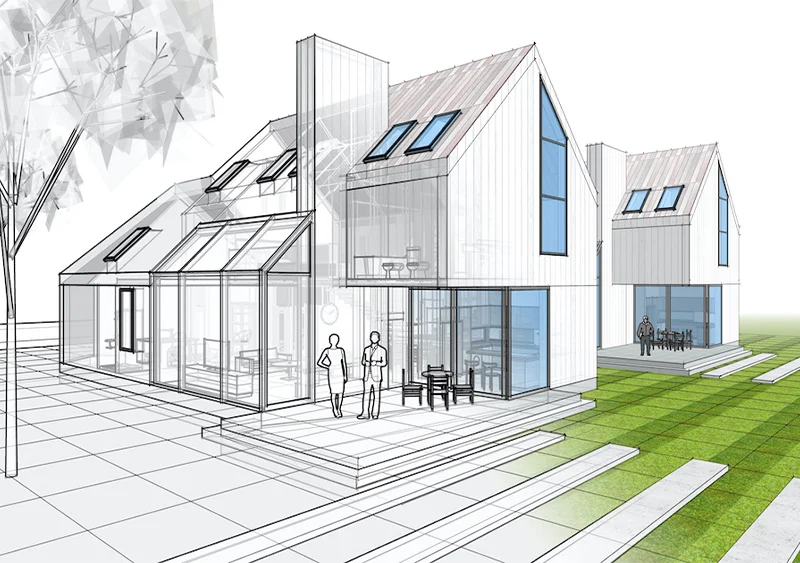Top 7 Benefits of 3D Rendering Services for Architecture
7 Game-Changing Benefits of 3D Rendering for Architectural Projects

4 MIN READ
March 19, 2025

Written By
Allwyn Ruban
3D rendering has become an essential tool for architectural firms, developers, and real estate companies. It enhances decision-making, improves client communication, and accelerates project approvals. Businesses that invest in high-quality 3D visualization gain a competitive advantage in today’s fast-paced industry.
Here are the key reasons why 3D rendering is a must-have for architecture professionals.
Top 7 Benefits of 3D Rendering Services for Architecture
Architectural projects require more than just technical accuracy. They demand clear communication, precise visualization, and a compelling presentation to secure approvals and investments.
3D rendering services have become an essential tool, allowing architects, developers, and real estate professionals to bring their vision to life with unmatched clarity and impact.
Here are seven key benefits of using 3D rendering in architectural design.
1. Better Client Communication with Realistic Visuals
Explaining a project through blueprints or sketches can be challenging. 3D rendering eliminates confusion by providing photorealistic visuals that clients can easily understand.
- Instead of relying on technical drawings, clients see a fully detailed, lifelike representation of the project.
- Visual storytelling becomes more effective, helping architects secure faster approvals and investments.
A well-rendered image makes it easier to align client expectations with the final outcome.
2. Faster Project Approvals and Decision-Making
In architecture, delays can be costly. Stakeholders often struggle to visualize designs from 2D plans, leading to prolonged decision-making.
- 3D renderings provide an instant, clear representation of the final structure, reducing back-and-forth discussions.
- Municipal authorities, investors, and clients can approve designs with greater confidence and fewer revisions.
By reducing uncertainty, projects move forward faster, saving time and resources.
3. Cost-Effective Design Revisions
Making changes during construction is expensive. 3D rendering allows architects to identify design flaws early and make adjustments without additional costs.
- Modifications can be tested digitally before physical work begins, preventing costly errors.
- Clients can request changes without affecting the project timeline, leading to smoother collaboration.
This proactive approach minimizes financial risk and improves overall project efficiency.
4. Competitive Edge in Marketing and Presentations
In real estate and development, first impressions matter. A well-executed 3D rendering can make a project stand out before it is even built.
- Developers use 3D visuals for pre-sales, marketing materials, and investor pitches.
- Interactive 3D models and virtual walkthroughs create a more immersive experience, increasing buyer confidence.
With stunning, high-quality renderings, architectural firms and developers attract more interest and secure contracts faster.
5. Seamless Collaboration Between Teams
Large architectural projects involve multiple stakeholders—architects, engineers, designers, and construction teams. Miscommunication can lead to costly mistakes.
- 3D renderings serve as a universal visual reference, ensuring everyone is aligned.
- Project details, material choices, and spatial relationships are easier to interpret, reducing misunderstandings.
This level of clarity streamlines teamwork and improves project execution.
6. Customization and Flexibility for Different Designs
Clients often want to see multiple variations of a design before making a decision. 3D rendering makes it easy to create and compare different versions without starting from scratch.
- Color schemes, materials, lighting, and layouts can be adjusted instantly, providing clients with a range of options.
- Architects can experiment with different concepts and fine-tune details, ensuring the best final design.
This flexibility improves client satisfaction and allows for more creative exploration.
7. Integration with Virtual Reality (VR) and Augmented Reality (AR)
The future of architectural visualization is interactive. 3D renderings can be integrated with VR and AR to provide immersive experiences.
- Clients and investors can walk through a digital version of the project using VR headsets.
- AR allows users to place virtual buildings or interiors into real-world environments, enhancing visualization.
These advanced technologies increase engagement, improve decision-making, and create a next-level presentation experience.
Conclusion
3D rendering is a necessity in modern architecture. From improving communication and reducing costs to enhancing marketing and decision-making, the benefits are clear.
Architects, developers, and real estate professionals who invest in high-quality 3D rendering gain a significant advantage. It speeds up approvals, enhances presentations, and streamlines collaboration.
Want to bring your projects to life with cutting-edge 3D rendering?
About the writer :
Allwyn Ruban heads business development and marketing at Zealous Services. He’s the go-to person for finding smart ... ways to grow their 3D services, from animation to modeling. With a knack for digital strategy, Allwyn is all about helping clients achieve their goals while expanding Zealous' reach in the industry. His friendly approach makes collaboration easy and effective.
Read MoreFrequently Asked Questions (FAQ)
How does 3D rendering benefit architectural firms?
3D rendering enhances design accuracy, project presentations, and client communication. It allows architects to visualize projects before construction, making approvals and revisions faster while minimizing costly errors.
Can 3D rendering improve real estate pre-sales?
Yes. Real estate developers use 3D renderings to market properties before construction begins. High-quality visualizations help potential buyers and investors see the final design, leading to quicker decision-making and increased sales.
What makes 3D rendering better than traditional blueprints?
While blueprints and 2D drawings provide technical details, they lack realism and spatial clarity. 3D rendering creates lifelike visualizations, helping stakeholders fully understand the design, layout, and materials before committing to construction.
Is 3D rendering cost-effective for architectural projects?
Yes. By identifying design issues early and reducing the need for physical models, 3D rendering helps firms save on revisions, material costs, and rework, making the entire process more efficient.
How can firms integrate 3D rendering into their workflow?
Firms can collaborate with experienced 3D rendering companies like ZealousXR to incorporate visualizations into their design and presentation process. This ensures high-quality, customized renderings that align with project goals and client expectations.